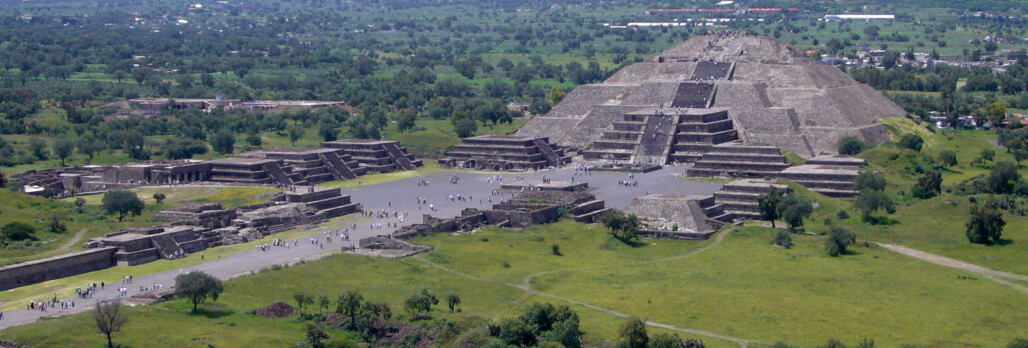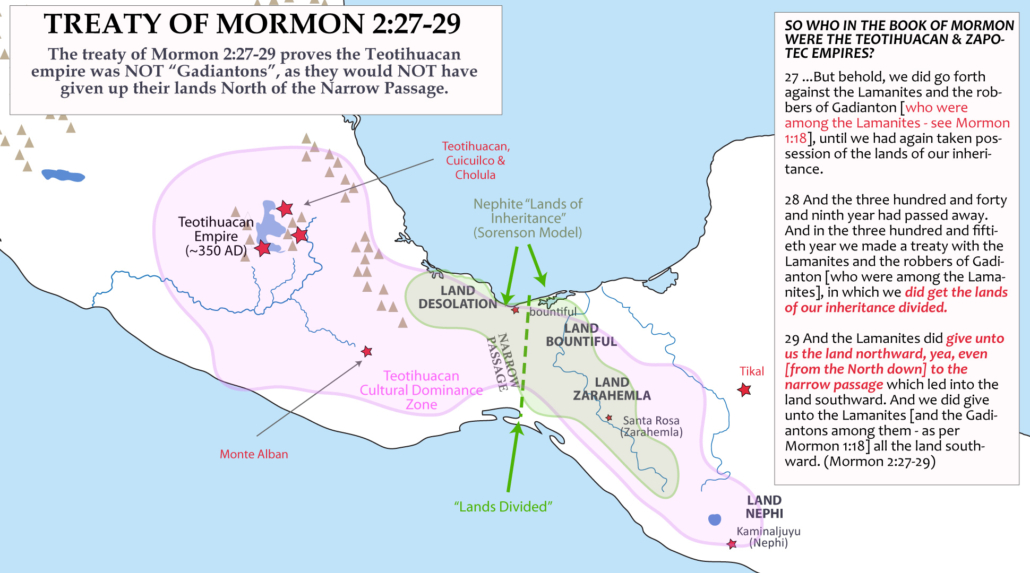No, Teotihuacan is NOT the Gadianton Robbers of the Book of Mormon

Ask yourself… does this sound like Mormon is talking about the largest nation state on the continent at the time? Or is he talking about a guerilla group of robbers like the FARC?
“18 And these Gadianton robbers, who were among the Lamanites, did infest the land, insomuch that the inhabitants thereof began to hide up their treasures in the earth; and they became slippery, because the Lord had cursed the land, that they could not hold them, nor retain them again.” (Mormon 1:18)
–
Are the Teotihuacanos in the Book of Mormon?
Some Book of Mormon geography researchers have suggested that the great Teotihuacan Empire of Central Mexico and possibly even the Zapotec’s of central Oaxaca were the “Gadianton Robbers” of Mormon 1:18 & Mormon 2:27–29 in the Book of Mormon.
This position however, is absolutely incongruent with what the Book of Mormon text describes of the Gadianton Robbers, which it consistently details as a gorilla rebel group who live in the mountains, “among the people”, just outside of civilization who occasionally participate with various “secret combinations” to take control of various government structures like the Colombian drug cartels and FARC guerrilleros of the 1990 to early 2000’s. (something we’ll detail in a minute from Hel 3-5 & 3 Ne 2-4).
Mormon 1:18 specifically clarifies that the location of the Gadianton robbers the Nephites were dealing with in both Mormon 1 & 2 were “among the Lamanites.” It does NOT say these Gadianton Robbers lived in the Land Northward, and it does NOT say or imply these Gadianton’s had rebuilt the destroyed city of Jacoboth (3 Ne 9:9). It says specifically that these Gadianton robbers were just those, “WHO WERE AMONG THE LAMANITES”. This is reiterated in Mormon 2:27 when he says “we made a treaty with the Lamanites and the robbers of Gadianton” [including the Gadianton’s because they were among the Lamanites–and had perhaps had taken over parts of their government as stated in 4 Ne.1:24]
Suggesting that the Gadianton robbers of the pre-Christian era of the Book of Mormon, morphed into a highly skilled and sophisticated empire like Teotihuacan, or that they took control of the Teotihuacan or Zapotec empires simply is NOT supported by the text of Mormon 1:18.
One could perhaps make a case for the idea that the people of these empires were part of those that began to “be called Lamanites” in about 300 AD because they rejected the Gospel (see 4 Ne. 1:38). But to suggest that they were largely composed of or ruled by the “robbers of Gadianton” from 4 Ne 1:42–46 and Mormon 1& 2 or part of the “treaty” mentioned in Mormon 2:29 is, simply not supported by the text.
Once you remember Mormon’s clarifying clause in Mormon 1:18, the words of Mormon 2:27–29 are far less ambiguous concerning the wars and treaty.
Read the three post time of Christ references in succession and you’ll see the picture they paint.
38 And it came to pass that they who rejected the gospel were called Lamanites… 42 And… that the wicked part of the people began again to build up the secret oaths and combinations of Gadianton… 46 And… that the robbers of Gadianton did spread over all the face of the land… (4 Nephi 42,46)
18 And these Gadianton robbers, who were among the Lamanites[!!], did infest the land, insomuch that the inhabitants thereof began to hide up their treasures in the earth; and they became slippery, because the Lord had cursed the land, that they could not hold them, nor retain them again. (Mormon 1:18)
27 …But behold, we did go forth against the Lamanites and the robbers of Gadianton [who were among the Lamanites], until we had again taken possession of the lands of our inheritance.
28 And the three hundred and forty and ninth year had passed away. And in the three hundred and fiftieth year we made a treaty with the Lamanites and the robbers of Gadianton [who were among the Lamanites], in which we did get the lands of our inheritance divided.
29 And the Lamanites did give unto us the land northward, yea, even [from the North down] to the narrow passage which led into the land southward. And we did give unto the Lamanites [and the Gadiantons among them] all the land southward. (Mormon 2:27–29)
With the clarifying clause we no longer can make the mistake of assuming that the Nephites were battling two separate entities. Something that we should have assumed anyway, as there isn’t a single battle mentioned by Mormon with the Gadiantons after the time of Christ! Nor can we assume that the Lamanites & Gadiantons occupied the land North of the narrow passage!
Making Teotihuacan & the Zapotecs into Lamanites or Gadiantons is contrary to what the text says of the treaty. “And the Lamanites did give unto us the land northward, yea, even [from the North down] to the narrow passage which led into the land southward. And we did give unto the Lamanites [and the Gadiantons among them] all the land southward” (Mormon 2:29)
The only way to stay loyal to the above text, and make Teotihuacan & the Zapotecs (who lived north of the narrow pass of Sorenson) into anything other than Nephites, would be to assume that they were a neutral group of neither Nephites or Lamanites that for some reason simply were not part of the conflict mentioned in Mormon 2:29. (A proposition riddled with its own logical and archaeological issues, because of the amount of archaeological influence seen from Teotihuacan in southern cities like Tikal & Kaminaljuyu by 300-350 AD.)
This is why authors such as Sorenson, sloppily imagined that Teotihuacan must be part of Mormon 2:29’s “Gadianton Robbers.” Because the archaeology shows they were at best aligned with the Lamanite cities and lands of his models, and at worst (and more likely) the masters of those “Lamanite” regions.

However, this idea fits neither the text of Mormon 1-2, nor the general explanation of what Mormon was referring to with “Gadianton Robbers” throughout the Book of Mormon narrative. Mormon explains clearly that the followers of Gadianton were ROBBERS or bandits who lived off of plunder in the wilderness and when possible took over the governments of civilized society. They were not builders nor tradesmen, nor craftsmen, nor religious priests. Nor were they separatists like the Amalekites or Zoramites which the Book is careful to separate from them. Note the wording in the following verses:
The Gadianton Robbers where a “Band” of Robbers & Murderers.
“4 For there was one Gadianton, who was exceedingly expert in many words, and also in his craft, to carry on the secret work of murder and of robbery; therefore he became the leader of the band of Kishkumen… 8 and also that it was the object of all those who belonged to his band to murder, and to rob, and to gain power, (and this was their secret plan, and their combination)
10 And it came to pass that Helaman did send forth to take this band of robbers and secret murderers, that they might be executed according to the law.
11 But behold, when Gadianton had found that Kishkumen did not return he feared lest that he should be destroyed; therefore he caused that his band should follow him. And they took their flight out of the land, by a secret way, into the wilderness; and thus when Helaman sent forth to take them they could nowhere be found.
12 And more of this Gadianton shall be spoken hereafter…
13 And behold, in the end of this book ye shall see that this Gadianton did prove the overthrow, yea, almost the entire destruction of the people of Nephi. (Hel 2:4–13)
The band or Gang of Gadianton are based hidden in the wilderness of the “more settled parts of the land”.
23 And it came to pass in the forty and ninth year of the reign of the judges, there was continual peace established in the land, all save it were the secret combinations which Gadianton the robber had established in the more settled parts of the land, which at that time were not known unto those who were at the head of government; therefore they were not destroyed out of the land.
(Hel 3:23)
They take over the Nephite government where possible. (About 30 BC in the Land of Zarahemla)
38 And it came to pass on the other hand, that the Nephites did build them up and support them, beginning at the more wicked part of them, until they had overspread all the land of the Nephites, and had seduced the more part of the righteous until they had come down to believe in their works and partake of their spoils, and to join with them in their secret murders and combinations.
Hel 3:38–39
39 And thus they did obtain the sole management of the government,
Even after a few short successful attempts of taking over the Government, the Gadianton Robbers still “retreat back into the wilderness”. Note this is nothing like the war with the Amalekites or other separatists groups based in cities. When this was the case, THE BOOK OF MORMON SAID SO!
24 And it came to pass that in the eightieth year of the reign of the judges over the people of Nephi, there were a certain number of the dissenters from the people of Nephi, who … commenced a war with their brethren.
25 And they did commit murder and plunder; and then they would retreat back into the mountains, and into the wilderness and secret places, hiding themselves that they could not be discovered, receiving daily an addition to their numbers…
26 And thus in time, yea, even in the space of not many years, they became an exceedingly great band of robbers; and they did search out all the secret plans of Gadianton; and thus they became robbers of Gadianton.
27 Now behold, these robbers did make great havoc, yea, even great destruction among the people of Nephi, and also among the people of the Lamanites.
32 … And the robbers did still increase and wax strong, insomuch that they did defy the whole armies of the Nephites, and also of the Lamanites; and they did cause great fear to come unto the people upon all the face of the land.
33 Yea, for they did visit many parts of the land, and did do great destruction unto them; yea, did kill many, and did carry away others captive into the wilderness, yea, and more especially their women and their children. (Hel 11:24–27)
Compare this to what is said of the FARC gorillas in Columbia,
“FARC received most of its funding—which was estimated to average some US$300 million per year—from taxation of the illegal drug trade and other activities, ransom kidnappings, bank robberies, and extortion of large landholders.. The National Centre for Historical Memory has also concluded that of the 27,023 kidnappings carried out between 1970 and 2010, the Guerillas were responsible for 90.6% of them.”
The strength of the FARC–EP forces was high; in 2007, the FARC said they were an armed force of 18,000 men and women; in 2010, the Colombian military calculated that FARC forces consisted of about 13,800 members, 50 percent of whom were armed guerrilla combatants (wikipedia)
Many similar guerilla forces and their successful and unsuccessful military coup attempts could be sited as contemporary examples of the Book of Mormon Gadianton Robbers.
(when I get some time, I’m going to add some more examples and a few more scriptures…)


